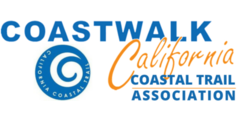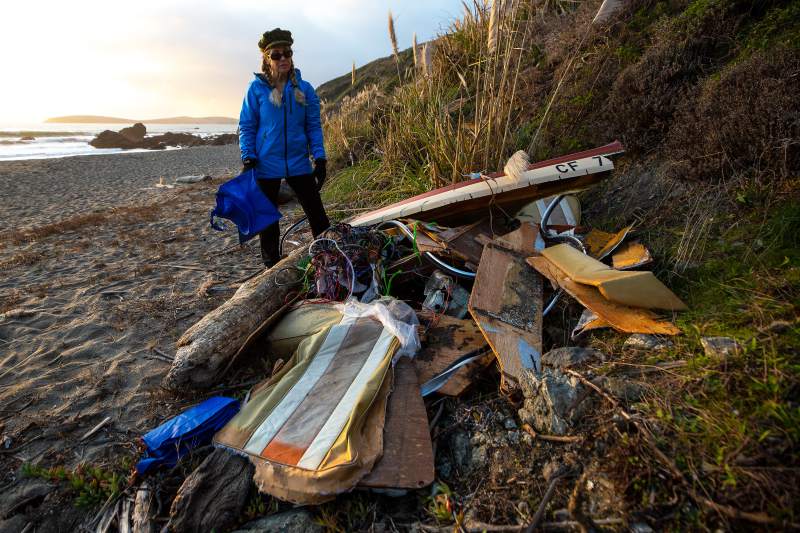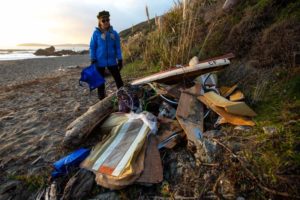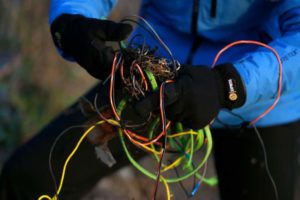BODEGA BAY – A hearty band of volunteers spent part of their weekend hauling chunks of boat wreckage up the side of a coastal bluff, completing a clean-up effort launched about a month ago when it became clear no one else planned to do anything about it.
The debris — splintered wood, twisted metal, pieces of Fiberglass hull, a tangle of wire and rope — was all that remained of a small boat that capsized in the surf near Pinnacle Gulch on Nov. 25, throwing a family of four in the ocean.
That family, rescued from the beach by helicopter and sent home to Sacramento, was technically responsible for removing the ruins of their watercraft.
But, as in other cases where boaters have walked away from crashed or grounded vessels on the Sonoma Coast, volunteers — led by well-known coastal steward Cea Higgins — picked up the slack.
“I wasn’t seeing anybody else stepping up to do it, and it was too much of a risk, with storms coming in,” said Higgins, executive director of Coastwalk/California Coastal Trail Association and a longtime officer with the local chapter of the Surfrider Foundation.
She pointed out a mass of snarled cords, mesh and other materials waiting to be cleared from the beach last week. “This kind of netting and rope is pretty scary for marine mammals and entanglement.”
It’s a case that reflects on a confusing, frustrating area of coastal policy — and more broadly, on a sizable problem with derelict and abandoned vessels throughout California waterways.
There are rules that dictate which area of government should hold jurisdiction over each forsaken boat — depending which side of the mean high tide line it’s on, for instance. But the rules apply only if someone cares to consider the matter in the first place, if the jurisdictional lines are clear and if there is money available for the job, a rarity.
“It’s super convoluted,” said state Fish and Wildlife Officer Mitch Goode, who works with the department’s Office of Spill Prevention and Response and has a lead role in state efforts to tackle the issue.
But there are hundreds of abandoned, sinking and nonseaworthy boats littering the Sacramento Delta, the extended reaches of the San Francisco Bay and all along the vast California coastline. They include three vessels that sank in Bodega Harbor years ago and yet remain, their owners in the wind or deceased.
The rusted steel hull of a fishing vessel driven up on South Salmon Creek Beach in 2016 also remains stranded in the surf line. Most of the hull is filled with sand.
“Anybody can become a fisherman, and if something bad happens, we’re all on the hook,” said self-styled “Coastodian” Richard James, a west Marin County environmental steward.
A Central Coast fisherman walked away from grounded vessels twice in 2012, months apart at the Point Reyes National Seashore and on the same Sonoma County beach near Pinnacle Gulch that was cleared Sunday of wreckage from November.
In the Point Reyes case, the National Park Service spent upwards of $80,000 demolishing and carting away a 43-foot commercial vessel owned by well-known fisherman Duncan MacLean, Supervisory Park Ranger John Eleby said. MacLean would soon ground another one in Bodega Bay, each time without insurance, Eleby and others said.
When MacLean grounded the 35-foot Sea Biscuit near Pinnacle Gulch and what Higgins calls Skimboarders’ Beach, volunteers were left with a mess of fuel-soaked debris far more toxic and troubling than the relatively small pile of sunbaked debris a group of 18 people tackled over the weekend.
“There’s no accountability,” James said, contending that owners can take their boats out uninsured and leave others holding the bag when they run into trouble.
In general, the process is clunky and inefficient when owners fail in their duty, leaving boats to break up and become environmental hazards, she said.
“It shouldn’t have to be that way. There should be processes in place. Because shipwrecks are a reality. We have treacherous beaches,” Higgins said.
Government agencies do not want to salvage wrecked boats unless it is part of their mandated responsibilities and they have funding for it, Goode said.
The U.S. Coast Guard is generally quick to arrange for removal of fuels and toxic substances from a stranded boat and might tow a vessel that’s deemed a hazard to navigation. But otherwise, boat salvage is not its function, officials said.
The Greater Farallones National Marine Sanctuary, working with the Coast Guard and National Oceanic and Atmospheric Administration’s law enforcement arm, might pitch in to resolve a situation involving a grounded vessel that could harm sanctuary resources, but only if there are funds available, said MaryJane Schramm, sanctuary spokeswoman.
“Right now the ‘pot’ is empty,” she said in an email.
The California Coastal Commission, meanwhile, has responsibility for boats that come ashore below the mean high tide line, while the owner of whatever property lies above that line — often the county or the state — is supposed to bear the burden for vessels that land higher up shore.
The boat that capsized in November may fit that description. Photos taken at the time of the rescues show the overturned boat in the surf before it was broken up and the pieces tossed on the beach.
Higgins, worried that the styrofoam, rope and everything else would be swept back to sea, began collecting the fragments a few weeks later and stashing what she couldn’t carry up the cliff higher on the beach until king tides hit earlier this month and she knew she had to get it off the beach altogether.
“If I started saying, ‘It’s your job; you should do it,’ then it doesn’t yield the results I’m looking for, which is trying to minimize the impacts in the most expedient way possible,” she said.
County parks, which owns the beach, pitched in Saturday with personnel, a dump truck and other supplies, helping to leave the beach clean.
But Higgins, 56, concedes the process must be fixed so the environment isn’t paying the price for gaps in government responsibility.
“I’m not going to be here forever,” she said. “What happens when I’m not around? Who’s going to do this?”
You can reach Staff Writer Mary Callahan at 707-521-5249 or [email protected]. On Twitter @MaryCallahanB.





